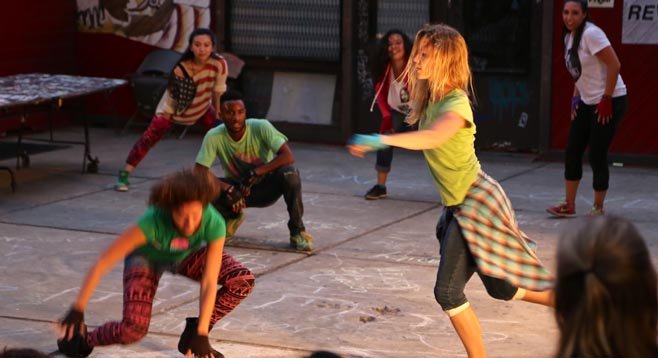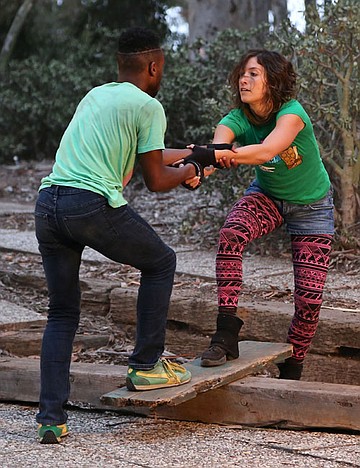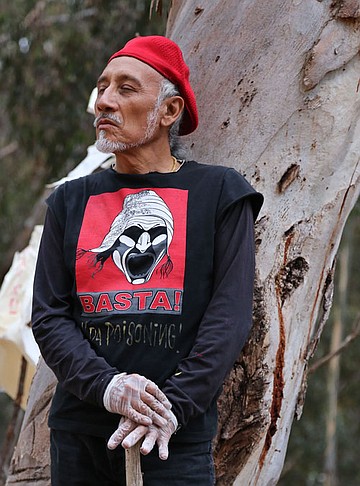 Facebook
Facebook
 X
X
 Instagram
Instagram
 TikTok
TikTok
 Youtube
Youtube

We’ve been hired to work at the world’s most important power plant, in the center of civilization. We will be responsible not just for providing energy to the masses but also for the air we breathe.
But wait: except for an official lanyard we wear, we have no experience. The folks in the office may have made a mistake. And given our two eccentric guides – one boasting he has a scar on his back that looks like Florida – mistakes and major FUBARs could be par for this course.
Talk about your specific sites. Cornerstone, written by UCSD’s David Jacobi and directed by Sarah Wansley, takes place at the Revelle College Power Plant. Amid indoor waterfalls, and large, rusty, metallic coupling-thingies, our group wends its way to a picnic table. Overhead’s a tangle of hissing and gurgling pipes, at least four-feet in diameter, and the light green, five story tower, just west of Gilman Drive.
The “realism” is fantastic in itself. We see what few outsiders do (unauthorized folks aren’t allowed inside the chain link fences). Great surges of energy engulf you – in ways no stage set could ever duplicate.
The site is also creepy, when the workers and their boss talk at cross-purposes and the fate of the world dangles in the balance. And what was that about a missing tower?
At one point a worker uses the expression “Kafkaesque.” Another says, “no, Sisyphusian,” and the third responds, “what’d you call me?”
Cornerstone combines often funny dialogue and an eye for the absurd with a message that blends in with the site and the piece.
Bring something to leave behind.
Cornerstone, Revelle College Power Plant, down the hill, east, from the “Theater District,” playing through Sunday, October 6; daily at 2:00 p.m. and 4:30 p.m.
The La Jolla Playhouse’s site specific festival presents works “without walls,” in the sense of not being staged in a theater – with the distancing, invisible proscenium in the way.
Some individual performances, however, are very much about walls. Hedda-ing looks at barriers as shelters or prisons, depending on one’s perspective.

The Myth Project’s Altar pays tribute to UCSD’s Che Café. The feisty, radical eatery – with large wall paintings of Caesar Chavez, Malcolm X, Angela Davis, and Karl Marx, among others - has somehow survived the slings and arrows of irate Late Capitalists for decades (promo says it’s been around since the “early 1980’s”; oh no. I can remember when the lunch “special,” a spicy chicken and rice dish, cost $.75 in the mid-to-late 1970s). Patricia Rincon, head of UCSD’s Dance Department and co-founder of the Myth Project, has choreographed a piece celebrating the café’s longevity and its function as a “neutral space,” a haven from univocal thinking.

A man in red beret sits at a typewriter. He is legendary Mario Terero, who painted many of the murals at the café and several at Chicano Park.
Fifteen dancers perform graceful, often extremely athletic moves. They contort, then flash upwards or shoot to the side, in sync or separate, as they reenact the history of the café. Many of their motions – to the music of Rage Against the Machine and Fat Freddy’s Drop – slam against walls. Or spider-creep across a façade. Or bond together to protect the café.
As in many site specific shows, the audience moves as well. During the hour-long performance observers move counter-clockwise from station to station around the building.
We come upon Terero re-painting one of his works, and expressive solo performances by Brian Bose and Sarah Navarrete. These two also combine for a dynamic, moving routine on a teeter-totter.
The Myth Project: Altar, Che Café, down the hill east from the “Theater District”: Saturday, October 5 at 2:00 p.m. Sunday, October 6 at 5:30 p.m.


We’ve been hired to work at the world’s most important power plant, in the center of civilization. We will be responsible not just for providing energy to the masses but also for the air we breathe.
But wait: except for an official lanyard we wear, we have no experience. The folks in the office may have made a mistake. And given our two eccentric guides – one boasting he has a scar on his back that looks like Florida – mistakes and major FUBARs could be par for this course.
Talk about your specific sites. Cornerstone, written by UCSD’s David Jacobi and directed by Sarah Wansley, takes place at the Revelle College Power Plant. Amid indoor waterfalls, and large, rusty, metallic coupling-thingies, our group wends its way to a picnic table. Overhead’s a tangle of hissing and gurgling pipes, at least four-feet in diameter, and the light green, five story tower, just west of Gilman Drive.
The “realism” is fantastic in itself. We see what few outsiders do (unauthorized folks aren’t allowed inside the chain link fences). Great surges of energy engulf you – in ways no stage set could ever duplicate.
The site is also creepy, when the workers and their boss talk at cross-purposes and the fate of the world dangles in the balance. And what was that about a missing tower?
At one point a worker uses the expression “Kafkaesque.” Another says, “no, Sisyphusian,” and the third responds, “what’d you call me?”
Cornerstone combines often funny dialogue and an eye for the absurd with a message that blends in with the site and the piece.
Bring something to leave behind.
Cornerstone, Revelle College Power Plant, down the hill, east, from the “Theater District,” playing through Sunday, October 6; daily at 2:00 p.m. and 4:30 p.m.
The La Jolla Playhouse’s site specific festival presents works “without walls,” in the sense of not being staged in a theater – with the distancing, invisible proscenium in the way.
Some individual performances, however, are very much about walls. Hedda-ing looks at barriers as shelters or prisons, depending on one’s perspective.

The Myth Project’s Altar pays tribute to UCSD’s Che Café. The feisty, radical eatery – with large wall paintings of Caesar Chavez, Malcolm X, Angela Davis, and Karl Marx, among others - has somehow survived the slings and arrows of irate Late Capitalists for decades (promo says it’s been around since the “early 1980’s”; oh no. I can remember when the lunch “special,” a spicy chicken and rice dish, cost $.75 in the mid-to-late 1970s). Patricia Rincon, head of UCSD’s Dance Department and co-founder of the Myth Project, has choreographed a piece celebrating the café’s longevity and its function as a “neutral space,” a haven from univocal thinking.

A man in red beret sits at a typewriter. He is legendary Mario Terero, who painted many of the murals at the café and several at Chicano Park.
Fifteen dancers perform graceful, often extremely athletic moves. They contort, then flash upwards or shoot to the side, in sync or separate, as they reenact the history of the café. Many of their motions – to the music of Rage Against the Machine and Fat Freddy’s Drop – slam against walls. Or spider-creep across a façade. Or bond together to protect the café.
As in many site specific shows, the audience moves as well. During the hour-long performance observers move counter-clockwise from station to station around the building.
We come upon Terero re-painting one of his works, and expressive solo performances by Brian Bose and Sarah Navarrete. These two also combine for a dynamic, moving routine on a teeter-totter.
The Myth Project: Altar, Che Café, down the hill east from the “Theater District”: Saturday, October 5 at 2:00 p.m. Sunday, October 6 at 5:30 p.m.
Comments